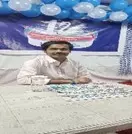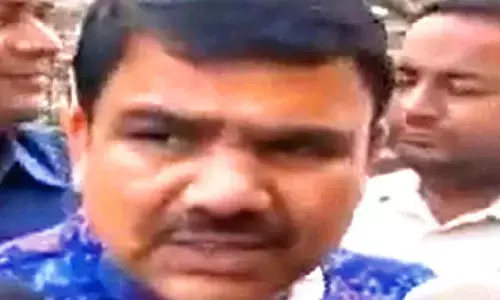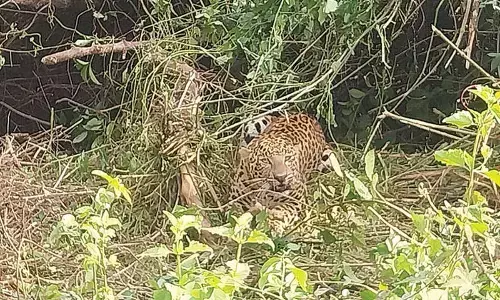CM KCR attends 'Maha Kumbha Samprokshana' ceremony in Yadadri

CM KCR attends 'Maha Kumbha Samprokshana' ceremony in Yadadri
Telangana Chief Minister K Chandrashekar Rao along with his family members on Monday attended the 'Maha Kumbha Samprokshana' ceremony held at Sri Lakshmi Narasimha Swamy Temple in Yadadri Bhuvanagiri district.
Yadadri: Telangana Chief Minister K Chandrashekar Rao along with his family members on Monday attended the 'Maha Kumbha Samprokshana' ceremony held at Sri Lakshmi Narasimha Swamy Temple in Yadadri Bhuvanagiri district.
The architectural masterpiece was constructed with 2,50,000 tonne black granite. The re-construction of the temple began in 2016 at a cost of Rs 1,280 crore and was executed by the Yadadri Temple Development Authority (YTDA). More than 2,000 sculptors and several workers were deployed for the renovation of the temple, which is still under progress. Elaborate arrangements have been made by the officials for the conduct of 'Maha Kumbha Samprokshana'. The authorities are making the necessary arrangements to handle the large number of devotees who are expected to arrive on Monday.
The temple management has set up an automated and mechanized prasadam production unit atop the hill. It is also learned that the devotees visiting the temple in Yadadri can get unlimited laddu, pulihora, and vada prasadam at the temple.
Interesting facts about Yadadri temple
Sri Lakshmi Narasimha Swamy Temple is also known as Pancha Narasimha Kshetram and Rishi Aradhana Kshetram) is situated on a hillock in the small town of Yadagirigutta in the Yadadri Bhuvanagiri district. The temple is an abode of Narasimha, an incarnation of Lord Vishnu. In 2016 a large expansion and rebuilding of the temple began.
According to Skanda Purana, Yada Maharishi, son of venerated Maharshi Rishyasringa performed penance here to Lord Vishnu as Narasimha. Being pleased with his penance Lord appeared before him and manifested himself in five forms: Jwaalaa Narasimha, Gandabheranda Narasimha, Yogananda Narasimha, Ugra Narasimha, and Lakshmi Narasimha.
Yada Maharishi begged Narasimha to remain on the hill in these forms. For this reason, the Lakshmi-Narasimhadeva temple on the hilltop has deities of Narasimha in all five forms embedded in stone in the main cave. Historically, the temple has followed the Thenkalai tradition of the Vaishnava Agama Shastras as followed.
The temple is in a cave about 12-feet high by 30-feet long, located in the back of the temple hall, by the rear pillar. You take a stairway down into the chamber and then toward the back. Jwala Narasimha is in the shape of a serpent, while Yogananda Narasimha appears sitting in meditation in a yoga pose. You will also see silver deities of Lakshmi-Narasimha, which are quite striking in appearance and lends the presence of seeing them. To the right of the temple's main door is a Hanuman temple. You'll see a long horizontal gap in the rock just below Hanuman. This is said to be where Gandabheranda Narasimha manifested. This is a very popular temple. It is said that any wish of a sincere devotee visiting this temple will be fulfilled. The sanctum sanctorum or Garbhagriha is located in a cave, under a huge slating rock, which covers half the abode.
The temple owned 39 kilos of gold and 1,753 tonnes of silver for lining the gopurams and walls in the temple. The centuries-old practice of using lime mortar to join different stone parts is being used. The YTDA acquired around 1900 acres by spending Rs 300 crores. Houses were also constructed near Vishnu Gundam (a place for taking bath).
The Seventh Nizam of Hyderabad, Mir Osman Ali Khan during his time also passed a grant of Rs.82,825 to this temple.
The architecture of the temple is based on Agama Shashtra. The temple is built entirely in stone. The temple was earlier built on 2 acres. After demolishing all structures on the temple hillock, the base for the temple is now 14 acres.
The principal architect is Anand Sai and lead architect P Madhusudhan, chosen for their understanding of the ancient designs based on silpa and Agama principles. The entire temple is built in stone. The stone designs in Yadadri were provided by the chief sthapathi of the temple, Soundara Rajan.
Three types are stones are being used for the temple like Krishna Sila (also known as Purusha Sila) for presiding deities in the sanctum sanctorum; Sthri Sila for deities of Goddesses; and Napunsaka Sila used for flooring, walls, etc. Black granite stone is also used, based on the temple architecture of the Kakatiya Dynasty in Telangana. The black granite stone has tiny pores, and it becomes strong and hard when milk, curd, oil, and other liquids get into those pores, according to learned shilipis (sculpture experts).


















